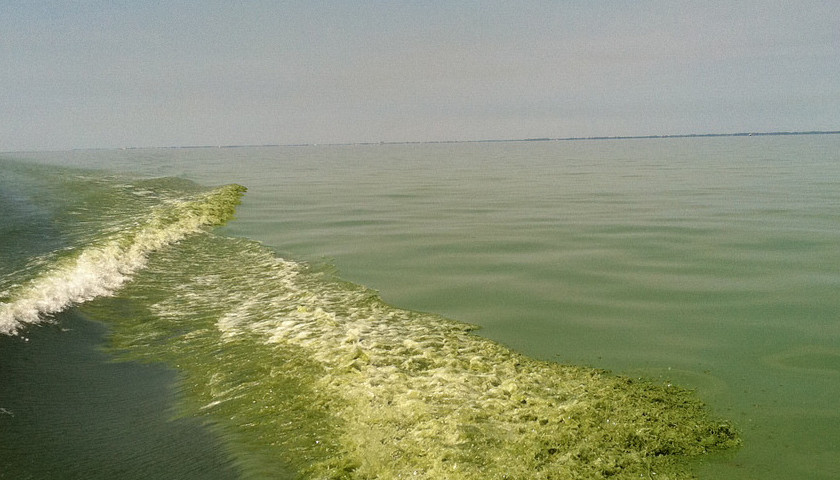A new pilot program designed to reduce phosphorus runoff into Lake Erie could give clearer insight into ongoing water quality programs — if its funding passes the Ohio legislature.
The program, dubbed the Shallow Run Pilot Program, would encourage area farmers to join a phosphorus-reduction program and then measure the water quality of the Shallow Run watershed.The Shallow Run Pilot Program is aimed at understanding if particular reduction practices lead to measurable changes in the water quality.
Runoff high in phosphorus — such as that coming from agricultural farms — has been linked to harmful algae blooms in Lake Erie. More than 85 percent of phosphorus entering the lake comes from agricultural farming, with the majority entering through the Maumee River watershed, according to research done by Ohio State University.
Harmful algae blooms, also known as Cyanobacteria blooms, produce toxins that are poisonous to humans if they get into the water supply. HABs caused a shutdown of the Toledo water supply in 2017.
Vice President of the Lake Erie Foundation Matt Fisher said that the potential program is a small-scale version of runoff-reduction programs currently being led by H2Ohio, Gov. Mike DeWine’s water quality program. The pilot program is spearheaded by several Ohio universities, the National Wildlife Federation and the Lake Erie Foundation, Fisher said.
The program is up for $4 million across fiscal years 2022 and 2023 in the budget currently before the Ohio legislature — funding Fisher fears may disappear after more than $70 million was cut from the H2Ohio program.
“We are concerned that could be axed,” Fisher told The Ohio Star, adding that he was “disappointed” that H2Ohio’s funding had been cut.
The sentiment was echoed by Bill Stanley, the Ohio director for The Nature Conservancy.
“Not only will these cuts to the program impede H2Ohio’s progress in improving our water quality, they will prolong the use of dangerous lead pipes that lead to daycares, and failing septic systems that pollute ground and surface waters,” Stanley said in a statement. “H2Ohio was designed with three ‘buckets’ of funding: natural infrastructure improvements, agricultural initiatives, and community water projects. Like three legs of a stool, they are meant to work together to improve water quality for Ohioans no matter where they live — whether that be the city or the country, from the shores of Lake Erie to the banks of the Ohio River. This decision would harm thousands of Ohioans by forcing them to continue to rely on unsafe drinking water and wastewater systems.”
H2Ohio, started by DeWine in 2019, is a statewide water quality control program. In addition to improving infrastructure like pipes, it also aims at reducing the phosphorus load in the Maumee Watershed by 40 percent, which research says would result in a reduction of harmful algae blooms.
The program uses a two-pronged approach that encourages farmers to join a voluntary run-off reduction program and increases the number of wetlands, which filter out and prevent nutrients like phosphorus from reaching Lake Erie.
In addition to increased wetlands, H2Ohio has recommended 10 “best practices” to reduce runoff. These include cover crops, soil testing, subsurface nutrient application, conservation crop rotation and vegetation buffers on the edge of fields, among others.
“These things have to work together,” Eric Saas, the H2Ohio program manager at the Ohio Department of Natural Resources
The program has plans for nearly 60 wetland projects, with fewer than 10 currently running, according to Saas.
More than 1,800 agricultural producers have joined voluntary programs to reduce phosphorus runoff, representing 44 percent of the farmland of the targeted area, according to a H2Ohio report on 2020’s results. As of April 2021, H2Ohio has also seen 150 farmers join the Water Quality Incentive Program, which provides farmers with a one-time payment of $2,000 per acre for taking cropland out of production and installing conservation practices like wetlands.
“We have had voluntary efforts for some time, but this is the first time that the state has provided significant resources to implement those agricultures [best management practices,” Joy Mulinex, the director of the Lake Erie Commission, told The Ohio Star.
Current modelling shows that once all of the planned projects are implemented, it should result in a 20 percent reduction in problematic run-off. However, updated management practices are being implemented in farm fields for the first time this growing season, meaning results are yet to come.
“We recognize that our algal bloom challenge is not going to go away immediately, it takes some time to get these practices up and running, so we will experience the HABs this summer, unfortunately,” Mulinex said.
Fisher said he hopes that the Shallow Run Pilot Program can demonstrate whether H2Ohio’s larger program will be effective.
“If this [program] doesn’t work, then the agricultural programs we’ve identified won’t show results,” Fisher said.
But H2Ohio is a step in the right direction, some say.
“We’re not just talking about it now, we’re doing something about it in a big way through H2Ohio,” said Saas.
Ohio’s 2022-2023 budget passed the state House of Representatives in April and is currently in the Senate’s finance committee.
– – –
Jordyn Pair is a reporter with The Ohio Star and the Star News Network. Follow her on Twitter at @JordynPair.





